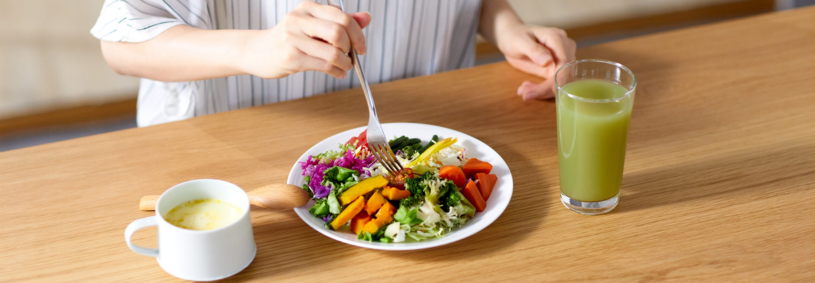Eating for Happiness: How Food, Flavour & Fermentation Lift Your Mood
- Blog
- Eating for Happiness: How Food, Flavour & Fermentation Lift Your Mood

Eating for Happiness: How Food, Flavour & Fermentation Lift Your Mood
Food can change how you feel—long before nutrients reach your bloodstream. Integrative medicine pioneer Dr Marc Cohen explores how flavour, ritual, the microbiome, blood sugar balance, and clean water shape our mood and long-term wellbeing.
Set and setting matter as much as nutrients
Our mood begins to shift well before the first bite. The intention, preparation, setting, aromas, anticipation, and the people we share meals with all prime digestion and enjoyment. Many cultures ritualise meals by taking a moment of thanks or acknowledging where the food comes from. These small practices calm the nervous system, support digestion, and set a positive emotional tone.
The flavour spectrum: a simple mood tool
Sweet can comfort, but balance is key. Aim to include the five flavours—sweet, salty, spicy, sour, and bitter—plus umami and a variety of textures (crunch, creaminess, long aftertaste). These flavours are often carried by polyphenols (especially flavonoids), plant compounds with antioxidant and anti-inflammatory effects that feature in many ‘feel-good foods’ such as berries, olive oil, dark chocolate, coffee, tea, red wine, high-quality honey, and fermented foods. Fermentation amplifies polyphenol content and deepens flavour.
Feed your microbiome, lift your mood
Most of the body’s serotonin is made in the gut. When the microbiome is diverse and well-nourished, gut–brain signalling improves and mood follows.
- Include a small amount of living ferments with meals such as yoghurt, kefir, kimchi, sauerkraut, pickles, or kombucha.
- Fermentation not only preserves food—it also increases nutrient density, a timeless strategy easily revived in modern kitchens.
Blood sugar stability = emotional stability
Rapid glucose spikes and crashes can drive irritability, cravings, and energy slumps. The poem 20 Essential Sugar Hacks outlines effective strategies for keeping blood sugar levels balanced.
20 Essential Sugar Hacks
Eat food in the right order
Fibre, fat and protein first
Add a dash of vinegar
Let filtered water quench your thirst
There is no need for counting calories
Just leave the sweets till last
Move your body after meals
Avoid those naked carbs
Only eat when hungry
Extend your fast at night
Eat with grace and colour
Enjoy the feast in the first bite
Try eating with the seasons
Enjoy different cuisines
Eat all the different parts of plants
Fungi, roots, flowers, fruits, and greens
Enjoy foods of many flavours
Bitter, salty, spicy, sour and sweet
Eat living ferments with each meal
Give your gut biome a treat
Don’t be rigid with your choices
And when push becomes a shove
Do what feels right in each moment
And eat the foods you love
#professorialpoetry
Colour your plate: carotenoids & anthocyanins
Eat the rainbow for mood and skin health. Carotenoids (reds, oranges, yellows) and anthocyanins (blues, purples) are potent antioxidants; carotenoids even contribute to a subtle, healthy glow. While isolated supplements have shown mixed results, whole foods remain the safest and most enjoyable approach.
Choose diversity—and eat low on the food chain
- Combine plant-based omega-3s (nuts, seeds) with small fish where suitable.
- Be mindful of biomagnification—pollutants and microplastics concentrate higher up the food chain.
- Choose organic animal products where possible.
- Eat SLOW: Seasonal, Local, Organic, and Whole. Embrace seasonal produce and, if you can, grow something yourself to add to your meals.
Water quality counts
What you drink with meals influences flavour, microbiome balance, and metabolic responses. Filtered water helps reduce contaminants that may disrupt taste and gut health, and minimises exposure to microplastics, endocrine disruptors, obesogens, and carcinogens.
Quick wins you can try today
- Eat with people you love—and take a moment to give thanks before you begin.
- Start meals with a bitter or sour opener (e.g., rocket salad with vinegar).
- Plate a rainbow and add one live ferment.
- Pair carbs with oil and vinegar; take a brief post-meal walk.
- Make a simple home ferment such as sauerkraut, kombucha, or kefir.
- Filter your water.
More about the author

Dr Marc Cohen
Dr Marc Cohen (Dr Marc) is an Australian medical doctor and integrative medicine leader whose work spans preventive health, hydrotherapy, fermentation, and food-as-medicine practices. He champions practical, evidence-informed habits that make wellness simple, joyful, and sustainable.
Disclaimer
This article is for education and general information only. It does not substitute for personalised medical advice. Always consult a qualified healthcare practitioner before making significant changes to your diet or lifestyle.
Other Blog In This Category

ATMS extends a huge congratulations to all the finalists in our annual Natural Medicine Awards!

